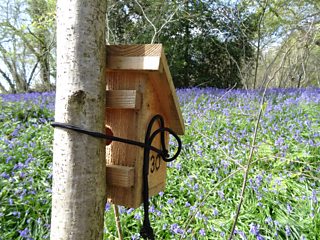Celebrating 30 years of conserving hazel dormice
People's Trust for Endangered Species (PTES)
Partner organisation of the Watches
Written by Ian White, Dormouse & Training Officer for PTES
I’m Ian White and I have the pleasure of being the only Dormouse Officer in the country, working for conservation charity People’s Trust for Endangered Species (PTES).
My job is fun, exciting, interesting, challenging, stressful, and very rewarding. But what do I actually do? I manage hazel dormice conservation in England and Wales, which involves running the National Dormouse Monitoring Programme (NDMP), organising annual dormouse reintroductions, training woodland owners and land managers about correct woodland management for dormice, and advising organisations across the country as to how they can help make their green spaces better for dormice.

Ian White with dormouse in hand by PTES
This year we’re celebrating the NDMP’s 30th anniversary, with a few highlights including:
- Since 1993 we’ve organised a reintroduction every year, releasing nearly 1,000 dormice into 24 sites across the country where they once existed. The population at our first reintroduction site at Brampton Woods in Cambridgeshire is still thriving.
- Since 2010 we’ve worked with HMP Humber who have built over 20,000 dormouse nest boxes - and counting – which are distributed across NDMP sites. A local timber supplier provides the materials and each box is handmade by HMP’s men. This increases their skills and gives dormice new homes too.
- We’ve trained over 1,000 people to manage dormouse habitat more sympathetically since 2010.
Celebrating 30 years of the National Dormouse Monitoring Programme (NDMP)
The NDMP is the longest and largest small mammal recording programme in the world, set up in 1990 to monitor dormouse populations across the country.
Fast forward 30 years and there are over 400 NDMP sites across southern England, parts of the Midlands and Wales. Each nest box is tucked away in quiet, hidden areas of woodland amongst dense scrub, where native, endangered hazel dormice call home.
Licensed volunteers carefully look for signs of dormice when they check each nest box during late spring, summer and early autumn. To date, a staggering 128,000 dormice have been recorded.

Dormouse next box in bluebell woodland by Henry Johnson
Dormice in decline
We’ve done all this work to find out how hazel dormouse are faring in the UK. And the truth is, not well. The NDMP has shown that we have lost over 50% of hazel dormice since 2000.
Does it matter? Yes; hazel dormice are a key indicator of a good, well-balanced environment – what’s good for dormice is often good for a thousands of other species too.
They’re incredibly cute, with sandy coloured fur, a furry tail and big black eyes. But, they’re also very vulnerable being so small, living in tree and shrub canopy and hibernating over winter. They’re a native species that’s been in Britain since the last ice age 10,000 years ago and are part of the ecological matrix that we’re also a part. To lose a native species is a loss to everyone.

Hazel dormouse in hand by Clare Pengelly
What’s happening to dormice?
Habitat loss is a major issue; dormice live in shrub and shrub canopy, and this rare habitat often gets shaded out as trees grow larger. Our woodlands have also become more isolated as larger, more industrial farms have less use for the hedgerows that once connective the countryside. Climate change also has a huge impact on dormice - mild winters increase the chance they’ll die during hibernation and wet springs can mean they produce fewer young. These reasons are very hard to change, so it will take time to turn this around.

Hazel dormouse by Hattie Spray
The future for hazel dormice
So if you go down to the woods today, you probably won’t see a dormouse. But, by continuing to educate woodland owners and land managers about how to maintain key dormouse habitat, running annual reintroductions and monitoring dormice via the NDMP, I hope that dormice will become a more familiar site in our woodlands in the future, but we won’t see change overnight.
I’m proud to work for PTES, and together we will continue to help bring dormice back from the brink. To find out how you can help dormice, visit .

Hazel dormouse up close by Clare Pengelly
